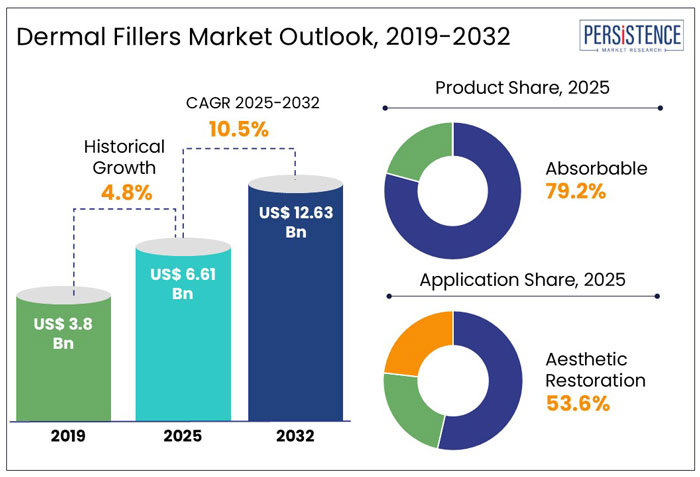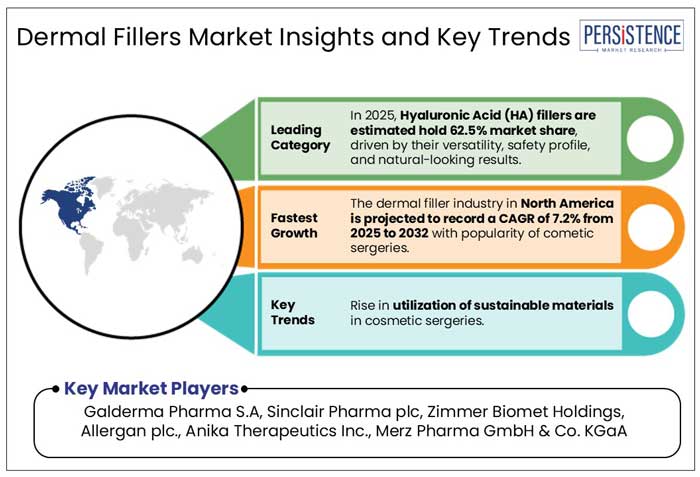Industry: Healthcare
Published Date: February-2025
Format: PPT*, PDF, EXCEL
Delivery Timelines: Contact Sales
Number of Pages: 184
Report ID: PMRREP33696
The global dermal fillers market size is anticipated to rise from US$ 6.61 Bn in 2025 to US$ 12.63 Bn by 2032. It is projected to witness a CAGR of 9.7% from 2025 to 2032.
In order to treat wrinkles, facial lines, lip augmentation, and acne scars, dermal fillers are a common non-invasive cosmetic surgery. The market is still expanding internationally owing to investments in research and development and creative product introductions. For instance,

Key Highlights of the Dermal Fillers Market
|
Global Market Attributes |
Key Insights |
|
Dermal Fillers Market Size (2025E) |
US$ 6.61 Bn |
|
Market Value Forecast (2032F) |
US$ 12.63 Bn |
|
Projected Growth (CAGR 2025 to 2032) |
9.7% |
|
Historical Market Growth (CAGR 2019 to 2024) |
8.8% |
Rising Demand for Jawline Enhancement Boosted Innovations in Novel Soft Tissue Fillers
The global dermal fillers industry witnessed a CAGR of 8.8% in the historical period between 2019 and 2024. In 2020, the COVID-19 pandemic caused the cosmeceuticals industry to reduce output, disrupt the supply chain, and impose import and export restrictions. However, following a decline in COVID-19-positive cases and a loosening of regulations, the worldwide dermal fillers industry rebounded in 2021.
Prominent industry participants, including CollPlant and Allergan Aesthetics, collaborated to create and sell dermal soft tissue fillers with recombinant human collagen generated from plants.
Shift toward Sustainable and Biodegradable Materials to Reshape the Future of Dermal Fillers
In the estimated timeframe from 2025 to 2032, the global market for dermal fillers is likely to showcase a CAGR of 9.7%. In order to enhance patient satisfaction and treatment results, dermal filler businesses are utilizing cutting-edge technology such as virtual reality, augmented reality, and artificial intelligence. Based on simulated pictures, these technologies may provide customized formulas and help patients select the best course of therapy.
Dermal filler firms will have greater chances as the cosmetic and plastic surgery industries change due to the introduction of sustainable and biodegradable materials. Both the overall quality of dermal filler treatments and the experience of patients will be improved by such a technique.
Growth Drivers
Rising Patient Interest in Non-surgical Aesthetic Procedures to Boost Innovation in Dermal Fillers
The simplicity and painlessness of minimally invasive cosmetic treatments is driving a spike in demand for dermal fillers worldwide. For instance,
Businesses are introducing goods that address certain requirements, including Galderma's RESTYLANE® EYELIGHTTM for the repair of infraorbital hollowing. Some businesses are collaborating to enter international markets. For example,
As more businesses use minimally invasive procedures, the market is anticipated to grow in the forthcoming period.
Need for Frequent Touch-ups and Long-term Expenses to Discourage Widespread Use
The demand for dermal fillers confronts several obstacles, such as expensive prices, strict regulations, and possible adverse effects include bruising, swelling, and muscle weakness.
The procedure's quality, which varies according to the practitioner's experience, time, and effort needed, is also impacted by the high cost. These drugs' temporary effects could necessitate recurrent treatments, which would be expensive for people.
Injection-related side effects include pain, bruising, swelling, redness, infections, lumps, bumps, eyesight loss, and severe scarring fueling the market's expansion. These elements might discourage adoption in underdeveloped nations and impede the growth of the global market.
High Demand for Cosmetic Enhancements to Bolster Research and Development Activities
Growing demand and more research and development initiatives are expected to propel the dermal filler treatments market upward. Businesses are creating cutting-edge fillers with a variety of cosmetic indications, which could support market expansion.
Market growth is aided by clinical studies and patents from different research and development projects. CollPlant Biotechnologies said in November 2023 that their photocurable dermal filler solution, which can raise skin and regenerate tissue, has been granted a patent.
The growing research and development in dermal filler treatments is driving market expansion. The market is likely to develop due to the predicted rise in cosmetic operations.
Product Insights
Convenience and User-friendliness Propelling Rapid Growth of Absorbable Fillers
In 2025, absorbable products are expected to dominate the market with a 79.2% share. The absorbable segment is the dominant market for dermal fillers due to their transient properties, appearance, and ease of application. These fillers, often made of synthetic polymers, hyaluronic acid, or collagen, are preferred for facial rejuvenation, wrinkle reduction, and lip enhancement.
As per Persistence Market Research, the global facial injectables market grew by 12.1% in 2023, reflecting increasing demand for minimally invasive aesthetic procedures. In 2025, the aesthetic restoration application is estimated to hold 53.6% of the global market. To take advantage of this growth, several industry players are estimated to innovate their products with novel designs. For instance,
Absorbable fillers remain the preferred choice due to their safety, natural tissue integration, and increasing preference for temporary, effective treatments despite increasing interest in non-absorbable fillers.
Ingredient Insights
Biocompatibility and Reversibility Make HA Fillers the Preferred Choice for Cosmetic Enhancements
In 2025, Hyaluronic Acid (HA) fillers are projected to dominate the dermal fillers market, holding a 62.5% market share, driven by their versatility, safety profile, and natural-looking results. HA fillers are popular for volume restoration, wrinkle reduction, and lip enhancement due to their biocompatibility and reversibility.
The global facial injectables market was valued at US$ 14.6 Bn in 2023, with HA fillers contributing to growth. On the basis of this market growth, market players are envisioned to develop products integrated of HA fillers. For instance,
Since HA fillers provide instant results, are predictable, and are widely used, they are recommended for collagen stimulation and volume enhancement in non-surgical cosmetic procedures.

Novel Healthcare Infrastructure and Skilled Practitioners Sustain North America's Dominance
In 2025, North America is likely to hold a 39.8% share of the global dermal fillers market, with a forecast CAGR of 7.2% from 2025 to 2032. It is driven by high awareness, increased disposable income, and a strong demand for aesthetic procedures in the region.
According to the American Society of Plastic Surgeons, the U.S. recorded 1,498,361 cosmetic filler procedures in 2022, highlighting growing consumer interest. The industry players are taking advantage of this trend by improving their products and getting regulatory authorizations. Such as,
With advanced healthcare infrastructure, skilled practitioners, and stringent regulatory oversight, North America remains the leading market for dermal fillers.
Rising Consumer Interest in Minimally Invasive Aesthetic Treatments to Propel Growth in Europe
In 2025, Europe is expected to hold a 30.2% share of the global dermal fillers market, with a forecast CAGR of 6.9% from 2025 to 2032. The market is driven by high demand for aesthetic procedures and increased research and development investment.
According to ISAPS, Germany recorded 254,743 hyaluronic acid procedures, making it a key player in the region’s cosmetic enhancement sector. In order to make their presence strong in the region, market players started developing strategic alliances. For instance,
Booming Aesthetic Sector and Beauty Consciousness to Fuel Demand in Asia Pacific
In 2025, Asia Pacific is projected to hold a 22.7% share in the global dermal fillers industry, with a forecast CAGR of 8.5% from 2025 to 2032. It is driven by increasing cultural acceptance of cosmetic procedures and a growing aging population.
According to the International Society of Aesthetic Plastic Surgery (ISAPS), South Korea, China, and Japan rank among the top countries for non-invasive aesthetic treatments. To develop their consumer base in these countries, different market players are estimated to boost their collaborative efforts with innovative strategies. For example,
The burgeoning aesthetic sector and increased beauty consciousness are driving up demand for dermal fillers in the Asia Pacific.
The global dermal fillers market is highly competitive, with established and new competitors. Innovative product introductions and investment in research and development are driving the market's global expansion. Their wide range of applications and robust product line are the reasons behind this. Regulatory bodies in the market are envisioned to boost the awareness across the globe by utilizing social media and other digital platforms.
To improve their market presence, other businesses are concentrating on strategic activities like introducing new goods and establishing partnerships. Prominent players are releasing new items in important markets to improve their revenue share. Market players are also implementing novel marketing campaigns to broaden their consumer base.
Key Industry Developments
|
Report Attributes |
Details |
|
Historical Data/Actuals |
2019 - 2024 |
|
Forecast Period |
2025 - 2032 |
|
Market Analysis Units |
Value: US$ Bn/Mn, Volume: As applicable |
|
Geographical Coverage |
|
|
Segmental Coverage |
|
|
Competitive Analysis |
|
|
Report Highlights |
|
|
Customization and Pricing |
Available upon request |
By Product
By Ingredient
By Application
By Distribution Channel
By Region
To know more about delivery timeline for this report Contact Sales

The market is set to reach US$ 6.61 Bn in 2025.
Dermal fillers, commonly used to create collagen and elastin, can last between 6 to 5 years.
Galderma Pharma S.A, Sinclair Pharma plc, Zimmer Biomet Holdings, and Allergan plc., are a few leading players.
The industry is estimated to rise at a CAGR of 9.7% through 2032.
North America is projected to hold the largest share of the industry in 2025.